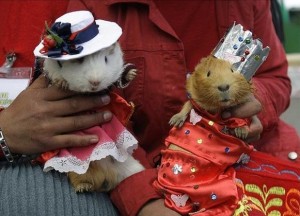 Cuy, or guinea pig, is a staple dish in many Andean countries, including Peru. If you come from a country where these little animals are kept as pets and never eaten, seeing a crispy cuy on your plate for the first time may come as a shock. However, if you can get past your culture shock and give this dish a try, you will be in for a treat.
Cuy, or guinea pig, is a staple dish in many Andean countries, including Peru. If you come from a country where these little animals are kept as pets and never eaten, seeing a crispy cuy on your plate for the first time may come as a shock. However, if you can get past your culture shock and give this dish a try, you will be in for a treat.
Cuy are valued as a meat source because they reproduce very quickly and require much less space and resources than larger livestock like goats and cattle. Their meat is high in protein and low in fat. Cuy are also used in religious ceremonies and for folk medicine diagnoses.
Far from being the poor man’s lunch, cuy was originally reserved for ceremonial meals. If you happen to be in Cusco, head to the Cusco Cathedral to see evidence of cuy’s respected status–you’ll find a painting of the Last Supper featuring a main course of cuy. Only since the 1960s has cuy become common fare in homes and restaurants alike.
Perhaps the most entertaining way to introduce yourself to cuy is by attending the annual “jaca tsariy” (collecting of the guinea pigs) festival. Different regions of Peru celebrate this festival in different ways. Sometimes the guinea pigs are placed in a miniature bull ring, sometimes they are killed and eaten in a ceremony satirizing local politicians, and sometimes they are simply collected for a feast.
The most famous cuy festival takes place in Huacho, Peru. This festival features a cuy cook off as well as cuy races an